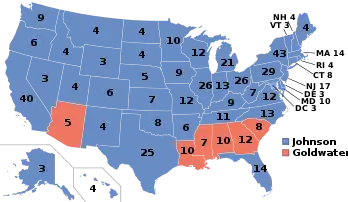1964 United States elections
The 1964 United States Elections were held on November 3, and elected the members of the 89th United States Congress, as well as the 45th Presidential Election. The Democratic party retained the presidency and added to their majorities in both chambers of Congress. This was the first presidential election after the ratification of the 23rd Amendment, which granted electoral votes to Washington, D.C.[2]
| Presidential election year | |
| Election day | November 3 |
|---|---|
| Incumbent president | Lyndon B. Johnson (Democratic) |
| Next Congress | 89th |
| Presidential election | |
| Partisan control | Democratic hold |
| Popular vote margin | Democratic +22.6% |
| Electoral vote | |
| Lyndon B. Johnson (D) | 486 |
| Barry Goldwater (R) | 52 |
 | |
| 1964 presidential election results. Red denotes states won by Goldwater, blue denotes states won by Johnson. Numbers indicate the electoral votes won by each candidate. | |
| Senate elections | |
| Overall control | Democratic hold |
| Seats contested | 35 of 100 seats (33 Class 2 seats + 3 special elections)[1] |
| Net seat change | Democratic +2 |
 | |
| 1964 Senate results
Democratic gain Democratic hold | |
| House elections | |
| Overall control | Democratic hold |
| Seats contested | All 435 voting members |
| Popular vote margin | Democratic +14.7% |
| Net seat change | Democratic +37 |
 | |
| 1964 House of Representatives results
Democratic gain Democratic hold | |
| Gubernatorial elections | |
| Seats contested | 25 |
| Net seat change | Republican +1 |
 | |
| 1964 gubernatorial election results
Democratic gain Democratic hold | |
Democratic incumbent President Lyndon B. Johnson (who took office on November 22, 1963, upon the death of his predecessor, John F. Kennedy) won a full term, defeating Republican Senator Barry Goldwater from Arizona.[3] Johnson won every state except for Arizona and the Deep South. Johnson won 61% of the popular vote, the largest share of the popular vote since 1820. Goldwater won the Republican nomination on the first ballot, defeating Governor William Scranton of Pennsylvania and Governor Nelson Rockefeller of New York.
The Democratic Party picked up 37 seats in the House and 2 seats in the Senate, thereby capturing veto-proof supermajorities in both chambers.
In the gubernatorial elections, the Republican Party won a net gain of one seat.
See also
References
- The Class 1 Senate seat in New Mexico held concurrent regular and special elections. That special election is not counted as part of the "seats contested."
- "Statistics of the Presidential and Congressional Election of November 3, 1964" (PDF). U.S. House of Reps, Office of the Clerk. Retrieved 10 April 2017.
- "1964 Presidential Election". The American Presidency Project. Retrieved 26 December 2011.